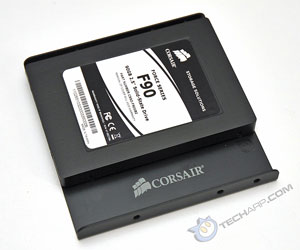The Connectors
 |
This is a Serial ATA drive, with native support for SATA 3.0 Gb/s. It is backward-compatible so you will have no problem using it with older SATA 1.5 Gb/s controllers. However, the faster SATA 3.0 Gb/s interface is necessary for optimal performance since the Corsair F90 solid state drive boasts a maximum internal (NAND-to-interface) read transfer rate of 285 MB/s.
Like all Serial ATA drives, it comes the standard SATA data (left) and power (right) connectors and is hot-pluggable. That means you can connect and disconnect this solid state drive to your PC while it's still running. There is no jumper block because there's really nothing for you to set.
Defragging The Corsair F90
Unlike hard disk drives, flash-based SSDs write and overwrite data in large blocks of 512 KB to 1 MB in size. Even if you only need to overwrite one byte of data, it has to erase and overwrite an entire block. This causes a lot of wear on the memory cells and greatly reduces their lifespan. To prevent that from happening, SSDs perform wear leveling by spreading the writes so that the flash memory cells have equal wear.
Newer SSDs also use a large write buffer to temporarily store and combine writes before they are actually written to the flash memory. This reduces the number of block erases and wear on the memory cells. Both wear leveling and write combining will eventually cause performance to degrade because of internal fragmentation. Unfortunately, this kind of fragmentation cannot be corrected by traditional disk defragmentation software.
To solve this performance issue, the drive must support some kind of garbage collection (either internally or via the operating system's support for the TRIM command). Alternatively, you can use a special SSD defragmentation software, or a newer hard disk drive defragmentation software that supports SSD defragmentation.
The good news is that the Corsair F90 supports TRIM out-of-the-box, so if you are using an operating system that supports TRIM (e.g. Microsoft Windows 7), you do not need to worry about internal fragmentation. If your operating system does not support TRIM though, then you are up the creek as Corsair does not provide any special defragmentation software with their SSDs, so you will have to rely on third-party SSD defragmenters to do the job.
3.5" Drive Bay Bracket
The Corsair F90 comes with a simple 3.5" drive bay bracket, which is basically a piece of folded sheet steel painted black. It looks virtually similar to the drive bay bracket that ships with the OCZ Vertex 2 (E) and OCZ Agility 2 (E) solid state drives. This bracket allows you to install the Corsair F90 solid state drive in a desktop. There are four screw points for you to attach the F90 (or any other 2.5" drive).
 |
 |
The second picture shows the Corsair F90 solid state drive properly secured to the 3.5" drive bay bracket. Once you attach the drive to the adaptor, just slide the entire assembly into any 3.5" drive bay and secure it with screws.
Support Tech ARP!
If you like our work, you can help support out work by visiting our sponsors, participate in the Tech ARP Forums, or even donate to our fund. Any help you can render is greatly appreciated!
Page |
Topic |
|
1 |
|
|
2 |
||
3 |
• The Corsair F90 Solid State Drive |
|
4 |
• The Connectors |
|
5 |
||
6 |
||
7 |
||
8 |
||
9 |
||
10 |
||
11 |
||
12 |
||
<<< The Corsair F90 Solid State Drive, Usable Capacity, Specifications : Previous Page | Next Page : Testing The Corsair F90 >>>







 Add to Reddit
Add to Reddit
